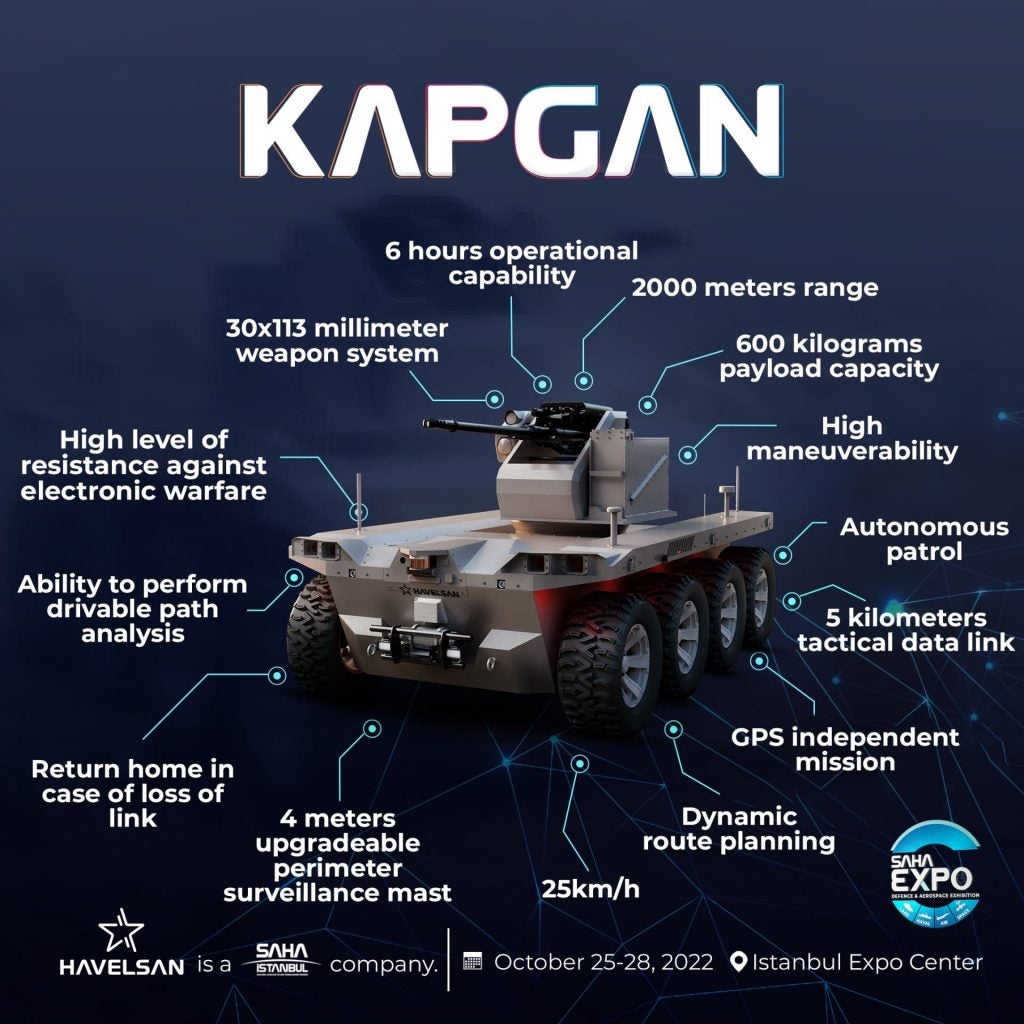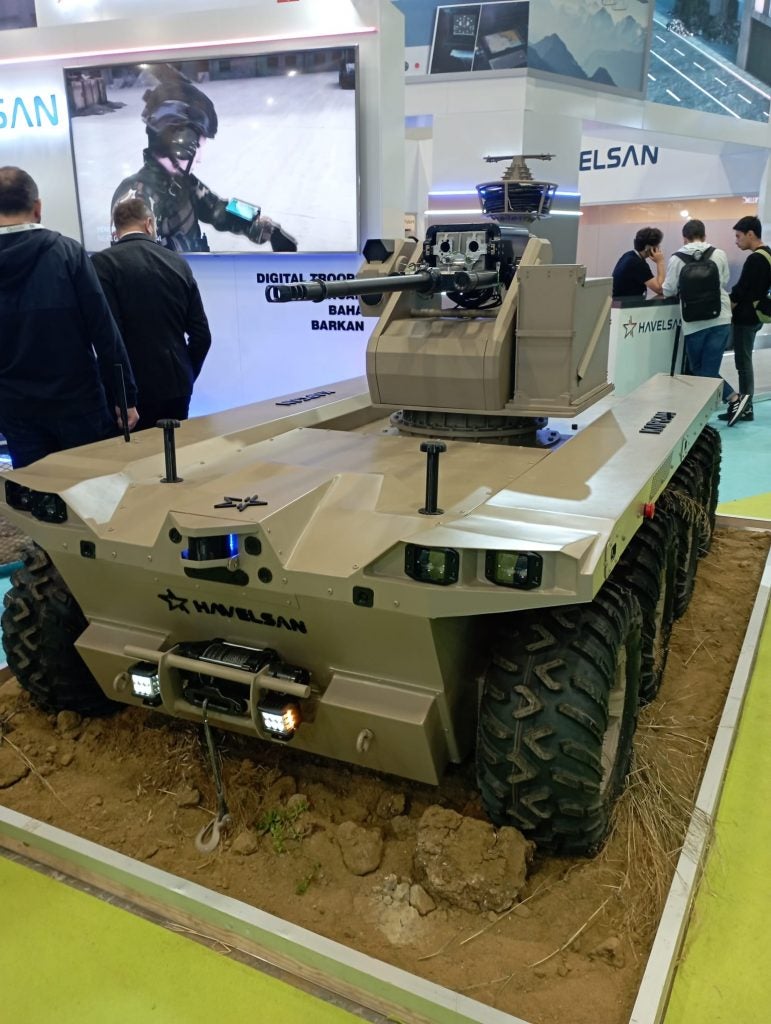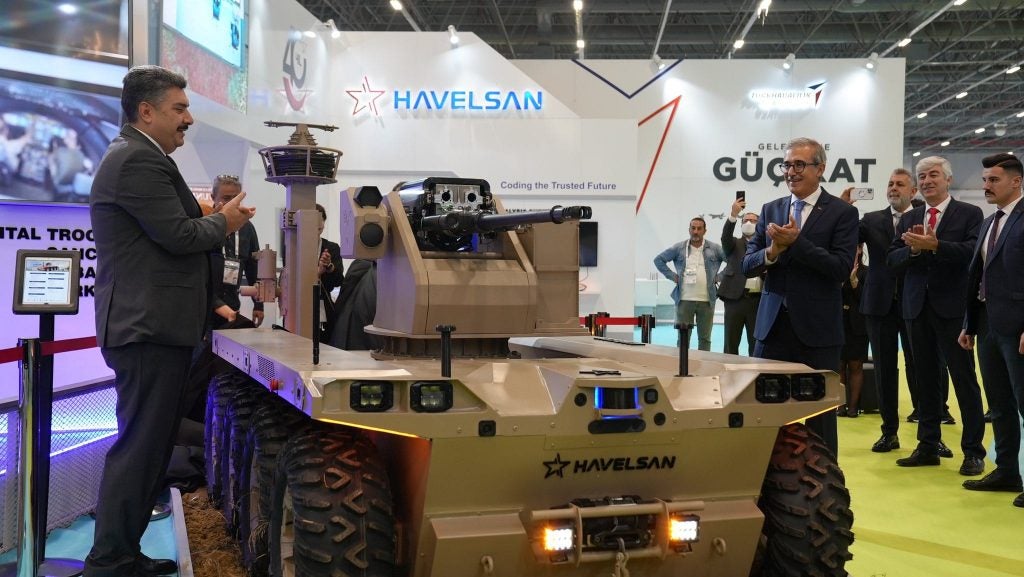SAHA EXPO 2022: HAVELSAN Exhibits its KAPGAN Armed Unmanned Ground Vehicle For The First Time
Havelsan, which operates in the defense and informatics sectors in Turkey, showcased the KAPGAN Armed Unmanned Ground Vehicle for the first time at the SAHA EXPO International Defense and Aviation Fair (running from the 25-28 October). The KAPGAN was developed within the scope of the “digital unit” concept that enables unmanned ground, air, and naval vehicles to work together in swarms. The KAPGAN launch ceremony was held at the HAVELSAN stand, with Prof. Dr. İsmail Demir, President of Turkish Defense Industry, and Dr. Mehmet Akif Nacar, General Manager of HAVELSAN in attendance. Defense Industry President İsmail Demir made the following statement on his social media account: “At SAHA EXPO, we unveiled our KAPGAN Heavy Class Unmanned Ground Vehicle. Our Turkish defense industry provides our security forces with yet another new product. I congratulate everyone who contributed.”
KAPGAN is an armed unmanned ground vehicle developed from the experiences gained during the development of BARKAN, HAVELSAN’s first unmanned ground vehicle produced after the Digital Unity Technologies R&D studies got underway in 2019. KAPGAN, which is derived from the name of the Göktürk Khagan and also means “conqueror,” will be used to meet the multi-operational needs of the battlefield, to support military units in all types of operational environments, to provide high mobility in difficult terrain, to collect information by patrolling, and to ensure the security of environmental conditions under enemy fire.
According to HAVELSAN, the vehicle with a length of 3.2 meters and a width of 1.75 meters weighs 1400 kg and has a useful load capacity of 600 kg. The vehicle, which is powered by an electric motor, has a top speed of 25 kilometers per hour and can operate for 6 hours. KAPGAN will be able to overcome 50 cm tall obstacles on rough terrain and operate at a depth of 120 cm at trench crossings, capable of climbing 70% steep slopes and holding on 40% side slopes. With the ability to perform autonomous patrols, GPS-independent missions, dynamic route planning, return home in the event of a connection loss, and drivable path analysis features, KAPGAN will be highly resistant to electronic warfare. The vehicle is equipped with a 30x113mm gun and is capable of providing day/night video feed and operation by sensing its surroundings via tactical data connection, GSM and satellite communication infrastructure, and an upgradeable perimeter surveillance system with a 5 km line of sight. The platform has a 2 km effective range and can easily neutralize air and ground targets. Furthermore, various types and calibers of weapon systems can be integrated into KAPGAN.

Within the scope of the “digital unit” concept, HAVELSAN aims for KAPGAN to be able to perform tasks in autonomous teams (swarms) with joint mission intelligence, as well as work cooperatively with other unmanned aerial, ground, and naval vehicles developed by HAVELSAN. Another goal of the concept in question is to control multiple unmanned vehicles with a single console and operator. The capabilities of autonomous UAVs and UGVs, which can work in swarms and teams, communicate with each other, and perform joint activities, have begun to be tested in the field. Unmanned surface vehicles will also take part in these trials in the near future.

HAVELSAN Unmanned Aerial and Ground Vehicles Project Manager Veysel Ataoğlu told an AA correspondent that the KAPGAN UGV will complete its mobility tests in two months and live-fire tests in the first quarter of 2023. After passing all tests, the system is expected to enter the Turkish Armed Forces’ inventory towards the end of 2024. The BAHA UAV, which was also developed by the company as part of the “digital unit” concept and whose design was recently updated, is expected to enter the Turkish Armed Forces inventory in 2023 after a few flight tests. In addition, SANCAR, Turkey’s third operational armed USV developed in collaboration with Yonca-Onuk Shipyard and HAVELSAN, was launched this year as part of the “digital unit” concept. However, it is currently unknown when its cruise tests will begin and when the vehicle will be ready for use.

